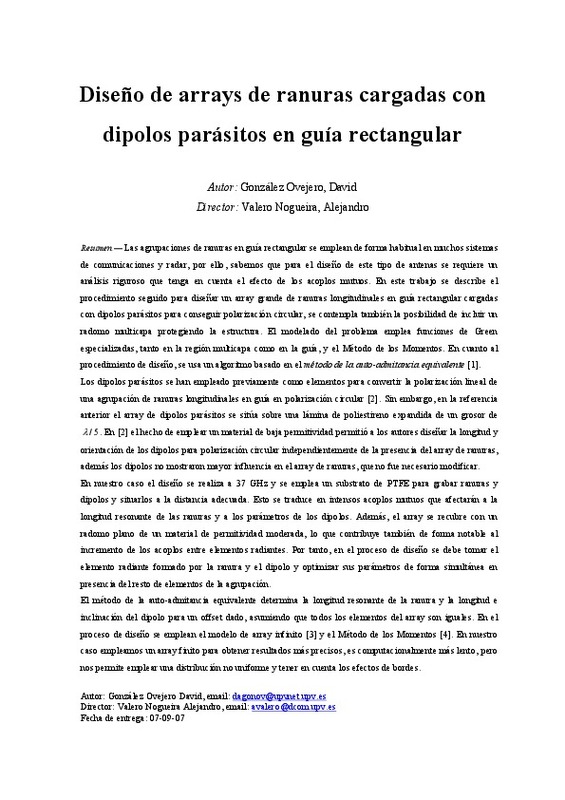JavaScript is disabled for your browser. Some features of this site may not work without it.
Buscar en RiuNet
Listar
Mi cuenta
Estadísticas
Ayuda RiuNet
Admin. UPV
Diseño de arrays de ranuras cargadas con dipolos parásitos en guía rectangular
Mostrar el registro sencillo del ítem
Ficheros en el ítem
| dc.contributor.advisor | Valero Nogueira, Alejandro
|
es_ES |
| dc.contributor.author | González Ovejero, David
|
es_ES |
| dc.date.accessioned | 2011-11-03T06:58:05Z | |
| dc.date.available | 2011-11-03T06:58:05Z | |
| dc.date.created | 2007 | |
| dc.date.issued | 2011-11-03 | |
| dc.identifier.uri | http://hdl.handle.net/10251/12537 | |
| dc.description.abstract | Se describe el proceso de diseño de un array grande de ranuras longitudinales resonantes cargadas con dipolos parásitos para conseguir polarización circular. El array se cubre con un radomo multicapa. El modelado se realiza mediante funciones de Green específicas de la región multicapa y de la guía y aplicando el Método de los Momentos (MoM). | es_ES |
| dc.description.abstract | [EN] Many microwave communication and radar antenna systems employ slotted waveguide arrays. The design of waveguide arrays of longitudinal shunt slots requires accurate mutual coupling analysis as is wellknown. This work describes the procedure followed to design a large array of resonant shunt slots loaded with parasitic dipoles to achieve circular polarization. The array is covered with a multilayer radome. The modelling technique uses specialized Green¿s functions for both the multilayer region and the rectangular waveguide region and the Method of Moments. The design procedure is based on the so-called equivalent self-admittance method [1]. Parasitic dipoles have been used previously as a way of converting linear polarization of an array of shunt slots into circular polarization [2]. In the case referenced, however, the array of parasitic dipoles was located on top of an expanded polystyrene sheet, about l/5 thick to accomplish design specifications. As reported by the authors, using a low permittivity material such as that let them design length and orientation of the dipoles to achieve circular polarization regardless of the presence of the slot array below. Besides the dipole array showed no major influence on the slot array which need not to be altered. In our case the array is designed at 37 GHz and a PTFE substrate is used to etch dipoles and slots at the proper distance from each other. This means that stronger mutual coupling will influence both slot resonant length and parasitic dipoles parameters. Furthermore, the array is covered with a flat radome of a moderate permittivity material which contributes noticeably to increase coupling among all radiators. Therefore, the design procedure should take both the slot and the dipole as the radiating element of the array to optimize its parameters simultaneously in the presence of the rest of array elements. The equivalent self-admittance method determines slot resonant length and dipole tilting and length for a given offset assuming all radiators of the array are the same. Therefore, the infinite array model [3] and the Method of Moments [4] are usually used as the analysis procedure. In our case we use a finite array model to obtain more accurate results. The model is computationally slower but allows us to use a non-uniform distribution and to take into account edge effects | |
| dc.format.extent | 40 | es_ES |
| dc.language | Español | es_ES |
| dc.publisher | Universitat Politècnica de València | es_ES |
| dc.rights | Reserva de todos los derechos | es_ES |
| dc.subject | Agrupación de ranuras | es_ES |
| dc.subject | Método de los momentos | es_ES |
| dc.subject | Funciones de green | es_ES |
| dc.subject.classification | TEORIA DE LA SEÑAL Y COMUNICACIONES | es_ES |
| dc.subject.other | Máster Universitario en Tecnologías, Sistemas y Redes de Comunicaciones-Màster Universitari en Tecnologies, Sistemes i Xarxes de Comunicacions | es_ES |
| dc.title | Diseño de arrays de ranuras cargadas con dipolos parásitos en guía rectangular | es_ES |
| dc.type | Tesis de máster | es_ES |
| dc.rights.accessRights | Abierto | es_ES |
| dc.contributor.affiliation | Universitat Politècnica de València. Servicio de Alumnado - Servei d'Alumnat | es_ES |
| dc.description.bibliographicCitation | González Ovejero, D. (2007). Diseño de arrays de ranuras cargadas con dipolos parásitos en guía rectangular. http://hdl.handle.net/10251/12537 | es_ES |
| dc.description.accrualMethod | Archivo delegado | es_ES |






